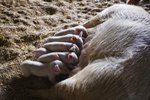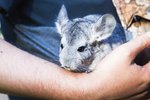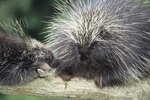
Marsupials, monotremes and placental mammals are the three branches of class Mammalia. Production of milk for their young is the one thing all mammals have in common; where the young develop is what divides them. Monotreme young hatch from eggs, placental young spend lengthy pregnancies connected to their mothers by umbilical cords and placentas, and marsupial young complete most of their fetal development attached to nipples in their mothers' pouches.
Why the Pouch?
The marsupial pouch isn't just a convenient way to carry a baby. Marsupials carry their young in pouches because the pouch is a life-support system for babies that are developmentally equivalent to placental mammal fetuses. In a sense, marsupial mammals traded nipples and lactation for placentas and umbilical cords. The pouch is the way they continue their pregnancies on the outside of the mother's body.
Pouch Life
Marsupial pregnancies begin in the uterus. Rather than developing a placenta, marsupial young leave the uterus between two and four weeks into the pregnancy, depending on species. These very undeveloped, hairless newborns share one well-developed feature: forelimbs with claws. The young climb from the mother's birth canal into the pouch, where they fuse to her nipples. They are nourished by their mother's milk and breathe the warm, moist pouch air, which has a different composition than outside air. The mother's milk changes as her babies' needs change, and as they become old enough to venture outside the pouch, they detach from the nipples. Older babies live outside the pouch but return to nurse for some time.
Types of Pouches
There are about 250 marsupial species and about 140 exist only in Australia. These species have a diverse variety of pouches. Some open forward, some backward, and some have vertical openings. A very few species (the numbats) have no pouches -- young fuse to nipples and cling to their mothers' fur. Some species become pregnant soon after one baby enters the pouch. The second baby stays in a dormant intrauterine stage until baby No. 1 begins venturing into the outside world. Baby No. 2 then climbs in and fuses to another nipple, whereupon mama becomes pregnant with her third and so forth. In other species, the mother has many nipples and may give birth to even more young at once, but only the ones who get to nipples first survive.
No Marsupial Bats?
There are marsupial versions of cats, dogs, weasels, bears and a host of other placental mammals. So the fact that there's never been a marsupial version of a few placental groups has puzzled some naturalists. There are no marsupial whales, bats or hoofed mammals. The reason is in the forelimbs. Marsupial infants must have well-developed arms with claws to climb into their mothers' pouches. This is why species with modified forelimbs (flippers, wings or hoofs) will never have a marsupial version.
References
Photo Credits
-
Photos.com/Photos.com/Getty Images
Writer Bio
Angela Libal began writing professionally in 2005. She has published several books, specializing in zoology and animal husbandry. Libal holds a degree in behavioral science: animal science from Moorpark College, a Bachelor of Arts from Sarah Lawrence College and is a graduate student in cryptozoology.




